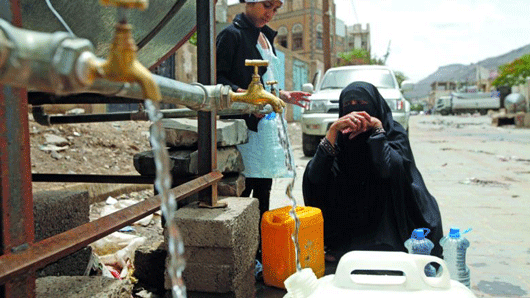
By Sarah El Shaarawi
It has been a year since the Saudi-led military campaign began in Yemen in an effort to return power to President Abd-Rabbu Mansour Hadi and compromise the territorial gains made by the Houthi Ansarullah movement ... in the country.
The escalation of the conflict, following the 2011 uprising, that toppled the regime of former President Ali Abdullah Saleh, has exacerbated an already severe water crisis that may ultimately determine the future of the country.
Traditional water conservation and harvesting methods are nowhere near sufficient to support the country’s current needs. And while other techniques have been adopted such as fog-harvesting, these are small-scale initiatives only feasible in the mountainous countryside and dependent entirely on environmental conditions.
Furthermore, crumbling infrastructure and neglect regularly has led to substantial wastage. The result has been a heavy reliance on ground water, but reserves of this nonrenewable resource are quickly running out, with projections for major wells to dry up as early as next year.
"When you talk to somebody who has 11 children and you say you must do something, they tell you with a big smile on their face that their wives are pregnant for the 12th time," says Ingrid Hehmeyer, an agricultural engineer and an expert on the history of hydraulic engineering and water management in Yemen.
"There’s no water, there’s no food, there’s no education, there are no jobs. If the population keeps growing at this rate, there’s not future for Yemen. It has just been too frustrating," adds Hehmeyer who has worked with the Yemeni government and international partners in program development and evaluation.
In 2010, the World Health Organization, (WHO) estimated that the country consumes 3.9 billion cubic meters of water annually, 1.4 billion of which comes from non-renewable sources. The WHO identifies the global water poverty line at 1000 cubic meters per capita per year.
In a 2009 publication, the World Bank indicated that Yemen had just 120 cubic meters of renewable freshwater resources per capita. By 2014 that number had dropped to 86 cubic meters.
What is now modern-day Yemen was once a key point in the ancient shipping route that connected the Indian Ocean to the Mediterranean. Merchants transported and traded frankincense and myrrh.
"This meant successful irrigated agriculture in a place that is today [a] desert," she adds.
The successful conservation of water continued throughout the medieval and Islamic periods, when imported water intensive crops like rice and sugarcane were successfully integrated into the agricultural output.
Since that time however, the landscape of the country has changed significantly. Prior to the outbreak of the current conflict, Yemen was already facing a number of serious issues placing a heavy burden on the country’s limited water resources.
Things have only gone worse over the past year. "During war, communities have no possibility to do anything but face the war," explains El Hethmy.
"Of course this affects water preservation, access, and cultivation. Cultivation has just stopped," he adds.
This interruption, combined with increasing difficulty in accessing certain areas of the country, are largely responsible for the current humanitarian crisis in Yemen.
Discussing a recent report in Cairo, Joost Hiltermann, Program Director of Middle East and North Africa for the International Crisis Group, reflects on the winners and losers of the conflict in Yemen.
"The arms industry is always a big winner. France, Britain and the United States are doing really well when it comes to arms sales. Another big winner is Al Qaeda and [Daesh]," says Hiltermann, as he notes the organizations’ skill at capitalizing on instability.
In March, U.N. Special Envoy to Yemen, Ismail Ould Cheikh Ahmed, announced a cessation of hostilities to begin at midnight on April 10, with U.N.-sponsored peace talks to take place in Kuwait.
While some question whether these talks would accomplish anything, others are optimistic.
"All Yemeni parties are coming to the table and they are convinced that they should reach a solution and a settlement that takes into consideration, as a first priority, the interests of Yemen," says El Hethmy.
But while peace and stability would provide some relief, the water crisis is not just symptomatic of the war.
Although many international analysts are pessimistic about the future prospects of the country both in terms of stability and resources, El Hethmy remains optimistic.
"All Yemen needs is peace and stability with the support of the international community," he says.
"Then the country will be able to stand on its own."
While I sit in his office he recites an old piece of Yemeni poetry, crudely translated into English as: "When Yemenis fight, and there is bloodshed, they remember they are brothers, and their tears shed." This, he says, is the secret to why crises in the country never last that long, and that is why he is optimistic that there will soon be a resolution.
Without resolution, the water crisis will only grow more severe.
Source: News Week Middle East, Edited by Website Team